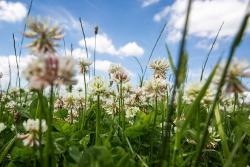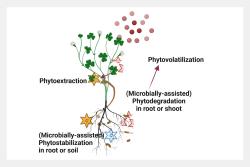Press Release, 25. March 2025
Using cover plants to remove pollutants from arable soil
New ways to improve soil health in agriculture
Nitrate, pesticides, metals, plastic – agricultural soils often contain pollutants. But are there sustainable and climate-friendly ways to restore and promote soil health in agricultural land? Yes, says a research team from the Helmholtz Centre for Environmental Research (UFZ). Specific plant species could be used as cover plants for phytoremediation, i.e. to relief agricultural land from adverse pollutant impacts. In their article published in Trends in Plant Sciences, the researchers summarise the results of more than 100 scientific studies and present which plants, according to current knowledge, are suitable for removing pollutants from agricultural soils or trapping them in their root systems.

Plant species grown as cover plants, such as clover, can remove pollutants from the soil or fix them in their root systems.
Photo: Harlekin-Graphics / AdobeStock

Various types of phytoremediation
Photo: Marie Muehe / UFZ
Farmers often grow so-called cover plants between main crops. They are used for purposes such as for animal feeds or remain on the field as green manure. In this way, they supply the soil with nutrients before the next planting. However, cover plants also protect against erosion, stabilise the soil's water, nutrient and carbon balance, regulate soil temperature, promote humus formation, sequester carbon dioxide and increase biodiversity above and below ground. "Cover plants are actually a kind of miracle tool in agriculture," says Prof Marie Muehe, head of the Plant Biogeochemistry working group at the UFZ and senior author of the publication. However, their potential for removing soil contaminants has yet to be recognised.
Using plants to remediate contaminants in the soil is nothing new. For example, contaminated soil on industrial sites is already being remediated in this way. But agriculture could also benefit from this method, says Marie Muehe: "The use of selected cover plants for phytoremediation is a natural, climate-neutral way to improve and maintain soil health. We should also apply this in the interests of sustainable agriculture."
But which plants are suitable for phytoremediation in agriculture? And which pollutants could be managed with which plants? The UFZ team investigated these questions and analysed the current status of research. "For example, we researched whether there are already studies that indicate which of the frequently used cover plants have the ability to break down contaminants. We also looked for plants that can break down or fix the pollutants in six categories - nitrate, salts, metals, pesticides, plastics and antibiotic resistance genes," explains first author Dr Pooja Sharma, who is also a researcher in the Plant Biogeochemistry working group at the UFZ.
Based on the results of the literature review, the research team developed concepts for phytoremediation for the respective pollutant categories. For example, rye and sunflower could be used as cover plants to prevent excess nitrate in the arable soil from being washed out and polluting the groundwater. The plants absorb the nitrate from the soil to grow and can remain on the field as green manure. However, cover plants that remove unwanted metals such as cadmium from the soil should be removed. Various types of clover, rye or rape could be used for this. "The cover plants used to remove metals are not generally suitable as animal feed. But they could play a role in the production of biogas," says Pooja Sharma. "Sunflowers are also good at removing metals from the soil. Potentially metals mainly accumulate in the leaves, so that the seeds could be harvested." The same applies to the seeds of mustard, which, as an intercrop, removes pesticides from the soil in the same way as grass or sunn hemp.
It was difficult to identify cover plants that are particularly suitable for phytoremediation targeting the contaminant categories of plastic or antibiotic resistance genes. The researchers discuss that the interactions between soil microorganisms and cover plants also play an important role in whether and how well pollutants can be fixed, degraded or removed by phytoremediation. "A lot of research still needs to be done here – working together with farmers. This is the only way to develop effective and practicable strategies for phytoremediation, tailored to different locations, soils and pollutant problems," says Marie Muehe. "From our perspective, using cover plants to manage soil pollutants could be an efficient future concept for healthier soils and more sustainable agriculture."
A UFZ research team will be launching a field study together with farmers as part of the SmartManure project in the summer of 2025. Their aim is to more closely investigate different cover plants and their remediation performance and to test the practicability of phytoremediation in agricultural practice.
Publication:
Pooja Sharma, Thomas Reitz, Surendra Pratap Singh, Anja Worrich and E. Marie Muehe: Going beyond improving soil health: cover plants as contaminant removers in agriculture, Trends in Plant Sciences, https://doi.org/10.1016/j.tplants.2025.01.009
Further information
Prof Dr Marie Muehe
UFZ Department of Applied Microbial Ecology / Head of the Plant Biogeochemistry Working Group
marie.muehe@ufz.de
UFZ press office
Susanne Hufe
Phone: +49 341 6025-1630
presse@ufz.de
In the Helmholtz Centre for Environmental Research (UFZ), scientists conduct research into the causes and consequences of far-reaching environmental changes. Their areas of study cover water resources, ecosystems of the future, environmental technologies and biotechnologies, the effects of chemicals in the environment, modelling and social-scientific issues. The UFZ employs more than 1,100 staff at its sites in Leipzig, Halle and Magdeburg. It is funded by the Federal Government, Saxony and Saxony-Anhalt.
www.ufz.deThe Helmholtz Association contributes to solving major challenges facing society, science and the economy with top scientific achievements in six research fields: Energy; Earth and Environment; Health; Key Technologies; Matter; and Aeronautics, Space and Transport. With some 39,000 employees in 19 research centres, the Helmholtz Association is Germany’s largest scientific organisation.
www.helmholtz.de